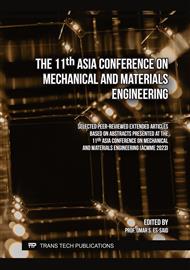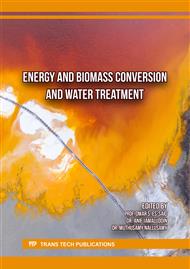[1]
J. Duan, K.O. Reddy, B. Ashok, J. Cai, L. Zhang and A.V. Rajulu: J. Environ. Chem. Eng. Vol. 4 (2016), p.440–448.
Google Scholar
[2]
C. Cabrera, R. Artacho and R. Giménez: J. Am. Coll. Nutr. Vol. 25 (2006), p.79–99.
Google Scholar
[3]
T. Zhao, Z. Chen, X. Lin, Z. Ren, B. Li, and Y. Zhang: Carbohydr. Polym. Vol. 184 (2018), p.164–170.
Google Scholar
[4]
M.A. Batiancela, M.N. Acda and R.J. Cabangon: J. Compos. Mater. Vol. 48 (2014), p.911–916.
Google Scholar
[5]
G. Xia, K.O. Reddy, C.U. Maheswari, J. Jayaramudu, J. Zhang and A.V. Rajulu: Int. J. Polym. Anal. Charact. Vol. 20 (2015), p.377–387.
Google Scholar
[6]
Y. Cao, S. Shibata and I. Fukumoto: Composites Part A: Applied Science and Manufacturing Vol. 37 (2016), p.423–429.
Google Scholar
[7]
D. Wu and M. Hakkarainen: Eur. Polym. J. Vol. 64 (2015), p.126–137.
Google Scholar
[8]
J. Chen, F. Chen, Y. Meng, S. Wang and Z. Long: Polymer Vol. 168 (2019), p.228–235.
Google Scholar
[9]
W. Jarowenko, in: Handbook of Adhesives 3rd ed., edited by I. Skeist, Chapman and Hall, NY (1990)
Google Scholar
[10]
J. Muller, C. González-Martínez and A. Chiralt: Materials Vol. 10 (2017), p.1–22.
Google Scholar
[11]
C. Chiarathanakrit, J. Mayakun, A. Prathep and K. Kaewtatip: Int. J. Biol. Macromol. Vol. 121 (2019), p.71–76.
Google Scholar
[12]
A.P. Mathew, K. Oksman and M. Sain: J. Appl. Polym. Sci. Vol. 97 (2005), p.2014–2025.
Google Scholar
[13]
T. Wittaya: Structure and Function of Food Engineering Vol. 1 (2012), pp.103-134.
Google Scholar
[14]
A.M.I. Balqis, M.A.R.N. Khaizura, A.R. Russly and Z.A.N. Hanani: Int. J. Biol. Macromol. Vol. 103 (2017), pp.721-732.
Google Scholar
[15]
R. Dangtungee, R. Srisuk and S. Siengchin: Advanced Materials Research Vol. 931–932 (2014), p.57–62.
DOI: 10.4028/www.scientific.net/amr.931-932.57
Google Scholar
[16]
V.P. Gouw, J. Jung, J. Simonsen and Y. Zhao: Composites Part A: Applied Science and Manufacturing Vol. 99 (2017), p.48–57.
Google Scholar
[17]
M. Rico, S. Rodríguez-Llamazares, L. Barral, R. Bouza and B. Montero: Carbohydr. Polym. Vol. 149 (2016), p.83–93.
Google Scholar
[18]
B.F. Bergel, L.M. da Luz and R.M.C. Santana: Prog. Org. Coat. Vol. 118 (2018), p.91–96.
Google Scholar
[19]
ASTM D618-61 Standard Test Method for Rubber Property-Durometer Hardness, in: ASTM Annual Book of American Standard Testing Methods, Philadelphia (1993)
Google Scholar
[20]
X. Huang, F. Xie and X. Xiong: Carb. Polym. Vol. 201 (2018), p.367–373.
Google Scholar
[21]
GB/T 27591 Standard for Paper Bowl, in: Chinese National Standard GB; GB/T; GBT, China (2011)
Google Scholar
[22]
ASTM D2240 Standard Practice for Conditioning Plastics and Electrical Insulating Materials for Testing, in: ASTM Annual Book of American Standard Testing Methods, Philadelphia (1993)
Google Scholar
[23]
M.A.A. Saidi, M. Ahmad, R. Arjmandi, A. Hassan and A.R. Rahmat: The Effect of Titanate Coupling Agent on Water Absorption and Mechanical Properties of Rice Husk Filled Poly(vinyl Chloride) Composites, in Natural Fibre Reinforced Vinyl Ester and Vinyl Polymer Composites, Woodhead Publishing (2018).
DOI: 10.1016/b978-0-08-102160-6.00010-x
Google Scholar
[24]
T. Nishino, K. Hirao, M. Kotera, K. Nakamae and H. Inagaki: Composites Science and Technology Vol. 63 (2003), p.1281–1286.
DOI: 10.1016/s0266-3538(03)00099-x
Google Scholar
[25]
A. Gacoin, G. Polidori, N. El Wakil, C. Bliard, H. Karaky and C. Maalouf: Construction and Building Materials Vol. 203 (2019), p.711–721.
DOI: 10.1016/j.conbuildmat.2019.01.127
Google Scholar
[26]
K. Tianyi and S. Xiuzhi: Cereal Chemistry Vol. 77 (2000), p.761–768.
Google Scholar
[27]
E.U. Offiong and S.L. Ayodele: Int. J. Sci. Eng. Res. Vol. 7 (2016), p.438–443.
Google Scholar
[28]
A. Nawab, F. Alam, M.A. Haq and A. Hasnain: Starch/Stärke, Vol. 68 (2016), p.1–10.
Google Scholar
[29]
J.W. Rhim, J.H. Lee and P.K.W. Ng: LWT - Food Science and Technology, Vol. 40 (2007), p.232–238.
Google Scholar



